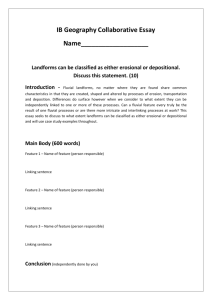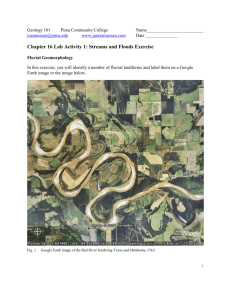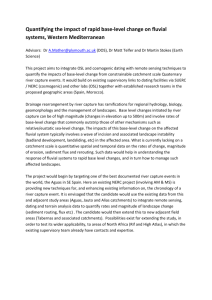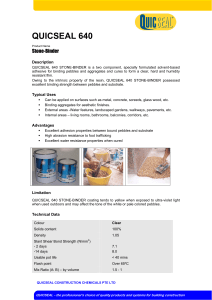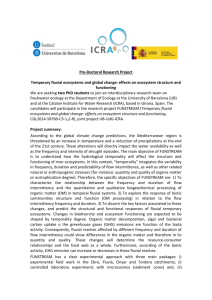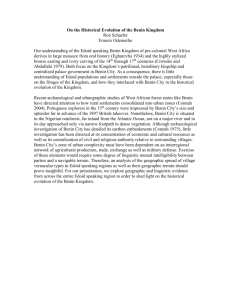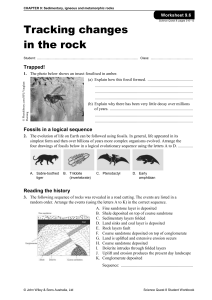Pebble Form Indices As Signatures Of The Depositional
advertisement
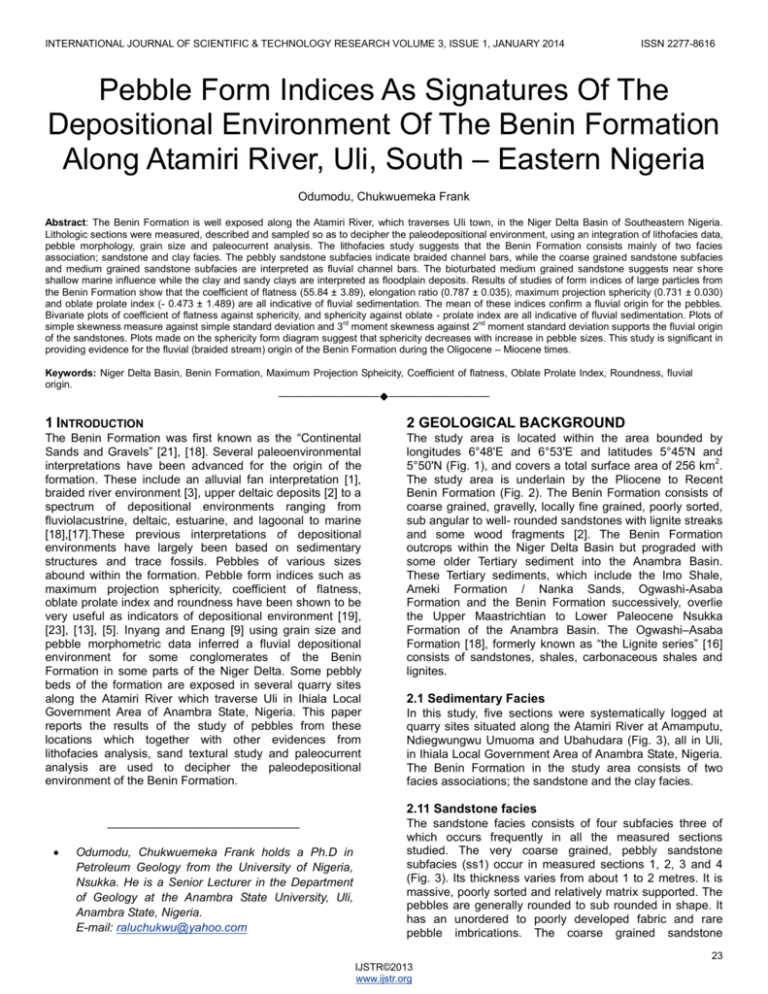
INTERNATIONAL JOURNAL OF SCIENTIFIC & TECHNOLOGY RESEARCH VOLUME 3, ISSUE 1, JANUARY 2014 ISSN 2277-8616 Pebble Form Indices As Signatures Of The Depositional Environment Of The Benin Formation Along Atamiri River, Uli, South – Eastern Nigeria Odumodu, Chukwuemeka Frank Abstract: The Benin Formation is well exposed along the Atamiri River, which traverses Uli town, in the Niger Delta Basin of Southeastern Nigeria. Lithologic sections were measured, described and sampled so as to decipher the paleodepositional environment, using an integration of lithofacies data, pebble morphology, grain size and paleocurrent analysis. The lithofacies study suggests that the Benin Formation consists mainly of two facies association; sandstone and clay facies. The pebbly sandstone subfacies indicate braided channel bars, while the coarse grained sandstone subfacies and medium grained sandstone subfacies are interpreted as fluvial channel bars. The bioturbated medium grained sandstone suggests near shore shallow marine influence while the clay and sandy clays are interpreted as floodplain deposits. Results of studies of form indices of large particles from the Benin Formation show that the coefficient of flatness (55.84 ± 3.89), elongation ratio (0.787 ± 0.035), maximum projection sphericity (0.731 ± 0.030) and oblate prolate index (- 0.473 ± 1.489) are all indicative of fluvial sedimentation. The mean of these indices confirm a fluvial origin for the pebbles. Bivariate plots of coefficient of flatness against sphericity, and sphericity against oblate - prolate index are all indicative of fluvial sedimentation. Plots of simple skewness measure against simple standard deviation and 3rd moment skewness against 2nd moment standard deviation supports the fluvial origin of the sandstones. Plots made on the sphericity form diagram suggest that sphericity decreases with increase in pebble sizes. This study is significant in providing evidence for the fluvial (braided stream) origin of the Benin Formation during the Oligocene – Miocene times. Keywords: Niger Delta Basin, Benin Formation, Maximum Projection Spheicity, Coefficient of flatness, Oblate Prolate Index, Roundness, fluvial origin. ———————————————————— 1 INTRODUCTION 2 GEOLOGICAL BACKGROUND The Benin Formation was first known as the “Continental Sands and Gravels” [21], [18]. Several paleoenvironmental interpretations have been advanced for the origin of the formation. These include an alluvial fan interpretation [1], braided river environment [3], upper deltaic deposits [2] to a spectrum of depositional environments ranging from fluviolacustrine, deltaic, estuarine, and lagoonal to marine [18],[17].These previous interpretations of depositional environments have largely been based on sedimentary structures and trace fossils. Pebbles of various sizes abound within the formation. Pebble form indices such as maximum projection sphericity, coefficient of flatness, oblate prolate index and roundness have been shown to be very useful as indicators of depositional environment [19], [23], [13], [5]. Inyang and Enang [9] using grain size and pebble morphometric data inferred a fluvial depositional environment for some conglomerates of the Benin Formation in some parts of the Niger Delta. Some pebbly beds of the formation are exposed in several quarry sites along the Atamiri River which traverse Uli in Ihiala Local Government Area of Anambra State, Nigeria. This paper reports the results of the study of pebbles from these locations which together with other evidences from lithofacies analysis, sand textural study and paleocurrent analysis are used to decipher the paleodepositional environment of the Benin Formation. The study area is located within the area bounded by longitudes 6°48'E and 6°53'E and latitudes 5°45'N and 5°50'N (Fig. 1), and covers a total surface area of 256 km2. The study area is underlain by the Pliocene to Recent Benin Formation (Fig. 2). The Benin Formation consists of coarse grained, gravelly, locally fine grained, poorly sorted, sub angular to well- rounded sandstones with lignite streaks and some wood fragments [2]. The Benin Formation outcrops within the Niger Delta Basin but prograded with some older Tertiary sediment into the Anambra Basin. These Tertiary sediments, which include the Imo Shale, Ameki Formation / Nanka Sands, Ogwashi-Asaba Formation and the Benin Formation successively, overlie the Upper Maastrichtian to Lower Paleocene Nsukka Formation of the Anambra Basin. The Ogwashi–Asaba Formation [18], formerly known as “the Lignite series” [16] consists of sandstones, shales, carbonaceous shales and lignites. _____________________________ Odumodu, Chukwuemeka Frank holds a Ph.D in Petroleum Geology from the University of Nigeria, Nsukka. He is a Senior Lecturer in the Department of Geology at the Anambra State University, Uli, Anambra State, Nigeria. E-mail: raluchukwu@yahoo.com 2.1 Sedimentary Facies In this study, five sections were systematically logged at quarry sites situated along the Atamiri River at Amamputu, Ndiegwungwu Umuoma and Ubahudara (Fig. 3), all in Uli, in Ihiala Local Government Area of Anambra State, Nigeria. The Benin Formation in the study area consists of two facies associations; the sandstone and the clay facies. 2.11 Sandstone facies The sandstone facies consists of four subfacies three of which occurs frequently in all the measured sections studied. The very coarse grained, pebbly sandstone subfacies (ss1) occur in measured sections 1, 2, 3 and 4 (Fig. 3). Its thickness varies from about 1 to 2 metres. It is massive, poorly sorted and relatively matrix supported. The pebbles are generally rounded to sub rounded in shape. It has an unordered to poorly developed fabric and rare pebble imbrications. The coarse grained sandstone 23 IJSTR©2013 www.ijstr.org INTERNATIONAL JOURNAL OF SCIENTIFIC & TECHNOLOGY RESEARCH VOLUME 3, ISSUE 1, JANUARY 2014 subfacies (ss2) were observed in all the sections studied. It consists of poorly sorted and prominently planar cross bedded, coarse grained sandstones with admixtures of dispersed pebbles in the matrix (Fig. 4a). The planar cross beds have unidirectional azimuths that point to the south. The medium grained sandstone subfacies (ss3) were observed in measured sections 1 and 2. It consists of poorly sorted medium grained sandstones. The thickness ranges from 3 to 8 metres. The prominent sedimentary structure is planar cross bedding. The cross beds show a paleoflow to the south and southwest.The bioturbated medium grained sandstone subfacies (ss4) occur below the pebbly sandstone subfacies and were observed in measured section 3. It is about 3 metres in thickness and contains very few Ophiomorpha burrows (Fig. 4b). The unit is also planar cross bedded with azimuths to the south and southwest. 7° E 1 0 11 1 2 ss2 Very coarse grained ss1 sandstone Poorly sorted, planar cross bedded coarse grained sandstone 12 Braided channel bars Fluvial Channel bars ss2 8 Poorly sorted, planar cross bedded, medium grained sandstone 4 Fluvial channel bars ss3 0 Sh Si Fs Ms Cs Ps Oba Nnewi Orlu1 Uli 0 Owerri 6° N A. Loc. 1 : Atamiri River, Amanputu – Uli Long. 6°48'72”E, Lat. 5°48’ 63”N, Elev. 28.68 m 5° N Fig. 3:- Lithologs of the studied sections of the Benin Formation, studied at different locations along the Atamiri River. Umuahia Ikot Ekpene 13 Alluvium Benin Formation Ogwashi–Asaba Formation Ameki Formation / Nanka Imo Formation Sands Study Area Geologic boundary 0 10 20 km 4° N LITHOLOGY DESCRIPTION INTERPRETATION NIGERIA 0 16 500 km ss2 9° E 8° E 7° E Ferruginized Fig. 1: Geological map of the Tertiary Niger Delta 6°48'E 6°53'E 5°50'N Ihiala 12 8 L7 4 Egwungwu Egbu Umuoma Anam. State Univ. Ndiayineji Ubahudara Atughobi 5°45'N 6°48' E Fig. 2: Location map of the study area Fluvial channel bars coarse grained pebbly Braided Channel bars sandstone Poorly sorted, planar cross bedded, coarse Fluvial grained sandstone Channel ss2 L6 Amamputu-Uli medium grained sandstone ss1 Very L8 L2 L5L4 L3L1 Afoegbu Fluvial channel bars 9° E 8° E 9 Onitsha 6°E Ferruginized medium grained sandstone 16 1 3 12 LEGEND 13 12 11 10 9 INTERPRETATION 20 2.12 Clay Facies The clay facies occur in measured sections 3 and 5. It consists of clay and sandy clay. The clay is about 0.3 metres thick while the sandy clay is 12 metres in thickness. 6° E DESCRIPTION LITHOLOGY ISSN 2277-8616 Poorly sorted, planar, cross bedded, medium grained sandstone bars Fluvial Channel bars ss3 0 5°45'N 6°53' E Sh Si Fs Ms Cs Ps B. Loc. 2:- Atamiri River, Amamputu – Uli Long. 6°48'722''E, Lat. 5°48'39''N, Elev. 9.8 m 24 IJSTR©2013 www.ijstr.org INTERNATIONAL JOURNAL OF SCIENTIFIC & TECHNOLOGY RESEARCH VOLUME 3, ISSUE 1, JANUARY 2014 DESCRIPTION LITHOLOGY 12 20 INTERPRETATION Fluvial channel bars 16 Ferruginized coarse grained sandstone Very coarse Braided grained pebbly bars sandstone 12 cl Fluvial channel bars ss1 8 4 INTERPRETATION ss2 ss2 Poorly sorted, coarse grained pebbly sandstone LITHOLOGY DESCRIPTION ISSN 2277-8616 8 Floodplain 4 channel ss2 Poorly sorted, planar cross-bedded coarse grained sandstone Fluvial channel bars 0 Sh Si FsMsCsPs C. Loc. 5 :- Atamiri River (Mmiri Father) Ubahudara-Uli Long. 6°51'23''E, Lat. 5°47'17''N, Elev. 15.04 m Sh Si Fs MsCs Ps Fig. 3:- Lithologs of the studied sections of the Benin Formation, studied at different locations along the Atamiri River. LITHOLOGY 20 16 12 8 4 E. Loc. 4:- Atamiri River, Ndiegwungwu-Umuoma- Uli. Long. 5°50'26''E, Lat. 5°47'52''N. Elev. 18.8 m. DESCRIPTION INTERPRETATION Ferruginized coarse grained sandstone LITHOLOGY DESCRIPTION INTERPRETATION 16 ss2 Fluvial channel bars ss2 ss2 12 Poorly sorted, Fluvial channel planar cross-bedded bars coarse grained sandstone cl Floodplain Very coarse grained Braided channel bars pebbly sandstone Ferruginized medium grained sandstone Fluvial channel bars ss1Very 8 Poorly sorted planar Fluvial channel bars cross-bedded medium ss4 grained sandstone coarse grained pebbly Braided Channel sandstone bars Poorly sorted, planar cross Fluvial bedded, coarse Channel grained sandstone bars ss2 4 0 Sh Si FsMsCsPs D. Loc. 3:- Atamiri River, Amamputu – Uli. Long. 6°15'53''E, Lat. 5°48'65''N, Elev. 13.16 m. 0 Poorly sorted, planar, cross bedded, medium grained sandstone Fluvial Channel bars ss3 Sh Si Fs Ms Cs Ps B. Loc. 2:- Atamiri River, Amamputu – Uli Long. 6°48'722''E, Lat. 5°48'39''N, Elev. 9.8 m 25 IJSTR©2013 www.ijstr.org INTERNATIONAL JOURNAL OF SCIENTIFIC & TECHNOLOGY RESEARCH VOLUME 3, ISSUE 1, JANUARY 2014 ISSN 2277-8616 were computed using some known statistical formulae as given below: Mean= x x (6) n x 2 S.D. = n 1 x 2 n n 1 (7) Where x = the deviations of each of the numbers Xj from the mean, n = the number of samples in a population and σ = the standard deviation of a population Table 1: Grain size scales for pebbles (modified from [24]) mm 48 - 64 32 – 48 24 – 32 16 – 24 12 – 16 8 – 12 6–8 4-6 Fig. 4a. - Planar crossbeds observed in the medium to coarse grained sandstone of the Benin Formation, (b) Ophiomorpha nodusa burrows crosscutting some planar crossbeds observed at an outcrop along Atamiri River at Uli 3 PROCEDURES AND METHODS Pebbles were picked randomly beneath the pebbly beds at each of the outcrops studied. The samples were washed and numbered. Broken pebbles were completely eliminated. Pebbles sampled include only pebbles with isotropic constitution, high resistance to wear and high abundance such as vein quartz.The three (Long, L; Intermediate, I and Short, S) axes of about six hundred pebbles from the five locations were measured with vernier calipers, using the procedures outlined by [22],[4]. The pebbles were also grouped into half – phi size classes according to the intermediate axes (see Table 1), the so called “sieve diameter” of pebbles. Roundness of pebbles were determined using a visual comparison with chart images compiled by [19], also used by [22], [13], [14], [15]. 3.1 Computations The values of the long, intermediate and short axes were loaded into the excel spreadsheet. The following formulas were imputed and used in computing the form indices for the 600 pebbles. S L 1 Elongation ratio [11] I L (2) Coefficient of flatness [11] S L *100 (3) Flatness ratio [11] Maximum Projection Sphericity [22] S 2 LI 13 (4) Oblate – Prolate Index [4] = LI 10 0.50 S L (5) L S Phi > - 5.5 > - 5.0 > - 4.5 > - 4.0 > - 3.5 > - 3.0 > - 2.5 > - 2.0 Class Term Pebble Granule Textural parameters were evaluated using sandstone samples from the Benin Formation. The conventional sieving procedure of [6] was used. The samples were carefully disaggregated and 50 gram of each sample was sieved using one phi sieve interval. A 15 minute’s sieving time was used. The critical percentiles (5φ, 16φ, 25φ, 50φ, 84φ and 95φ) were determined using the plotted cumulative probability curves. Textural parameters calculated using the appropriate formulae (see Table 2) include graphic mean (Mz), inclusive graphic skewness (Sk) and inclusive graphic standard deviation (σo), and moment mean grain size (m1), moment standard deviation (m2) and moment skewness (m3). These parameters were used in bivariate plots for paleoenvironmental reconstruction. 4 RESULTS The calculated form indices as well as roundness data are listed in Tables 3, 4 and 5. The form indices are represented in graphs of plots of coefficient of flatness against sphericity (Fig. 5a) for comparison with the results of [23] and plots of sphericity against oblate – prolate index (Fig. 5b), following the method of [4]. The total mean coefficient of flatness, Elongation Ratio (E.R.), Sphericity (M.P.S.I.), OP Index and roundness for pebbles of the Benin Formation are respectively 55.84, 0.787, 0.731, 0.473 and 0.739. The total mean coefficient of flatness for the Benin Formation (55.84 ± 3.891) indicate a fluvial environment. The total mean E.R. (0.787 ± 0.035) for the Benin Formation pebbles are suggestive of torrent type flowing water or brooks and rivulets [11]. The total mean M.P.S.I. and OP Index (0.731 ± 0.030, – 0.473 ± 1.489) for pebbles of the Benin Formation are indicative of fluvial environments (Dobkins and Folk, 1970) Means and standard deviations of the morphometric indices 26 IJSTR©2013 www.ijstr.org INTERNATIONAL JOURNAL OF SCIENTIFIC & TECHNOLOGY RESEARCH VOLUME 3, ISSUE 1, JANUARY 2014 ISSN 2277-8616 Table 2. Statistical parameters of sandstones used in this study STATISTICAL PARAMETERS st Mean (1 Moment ) Standard deviation or sorting( 2 nd Moment) FORMULA AUTHOR x [7],[8] = Σfmφ / 100 σ= Σf (mφ- “ x )2 / 100 “ rd α3 = Σf (mφ- Skewness ( 3 Moment ) x )3 / 100 σ3 “ th x )4 / 100 σ4 Kurtosis ( 4 Moment ) Σf (mφ- Graphic mean 1/3(φ16+ φ50+ φ84) [6] Inclusive (graphic) Skewness “ “ Inclusive ( graphic ) Standard deviation Table 3 : Results of pebble form indices for the Benin Formation n 20 20 20 20 20 20 20 20 20 18 20 20 19 20 20 20 20 20 20 20 20 20 20 18 s/no L1 / S1 L1 / S2 L1 / S3 L1 / S4 L1 / S5 L3 / S1 L3 / S2 L3 / S3 L3 / S4 L3 / S5 L5 / S1 L5 / S2 L5 / S3 L5 / S4 L5 / S5 L6 / S1 L6 / S2 L6 / S3 L6 / S4 L6 / S5 L7 / S1 L7 / S2 L7 / S3 L7 / S4 MEAN STD. DEV. L I S S/L S / L *100 I/L 28.01 29.24 23.26 26.39 21.43 39.65 43.53 35.60 39.52 38.98 28.97 27.47 29.13 33.99 25.31 31.93 34.84 32.65 36.20 31.71 27.00 26.58 22.22 25.14 30.78 21.39 21.48 18.74 19.53 17.31 31.97 32.06 28.57 29.98 31.17 22.70 22.63 22.95 24.62 20.84 25.55 27.44 26.53 28.50 26.19 19.75 18.61 15.73 18.43 23.86 4.89 16.27 16.89 13.21 14.84 13.08 20.53 22.44 20.01 20.95 22.55 15.16 16.30 16.58 18.84 14.15 16.75 17.92 17.21 18.95 19.34 12.68 13.79 10.23 12.89 16.73 3.29 0.586 0.590 0.580 0.576 0.611 0.538 0.538 0.572 0.584 0.591 0.541 0.608 0.590 0.563 0.563 0.530 0.524 0.537 0.539 0.626 0.489 0.542 0.466 0.514 0.558 0.039 58.61 59.04 58.00 57.60 61.07 53.80 53.79 57.24 58.35 59.14 54.14 60.84 58.97 56.30 56.27 53.04 52.39 53.67 53.96 62.63 48.89 54.23 46.59 51.48 55.84 3.891 0.772 0.748 0.810 0.753 0.816 0.820 0.758 0.809 0.798 0.808 0.794 0.829 0.809 0.737 0.833 0.806 0.796 0.818 0.802 0.823 0.747 0.731 0.718 0.751 0.787 0.035 Legend : L = Long axes, I = Intermediate axes, S = Short axes, index L –I/ LS 0.567 0.607 0.480 0.583 0.498 0.397 0.502 0.473 0.468 0.472 0.462 0.474 0.448 0.600 0.422 0.414 0.431 0.413 0.439 0.454 0.502 0.559 0.544 0.514 0.488 0.061 ψ 0.761 0.771 0.746 0.759 0.769 0.700 0.721 0.735 0.745 0.753 0.711 0.762 0.752 0.754 0.716 0.700 0.700 0.703 0.711 0.777 0.682 0.731 0.672 0.707 0.731 0.030 OP Index 0.746 2.036 - 0.684 1.495 - 0.393 - 2.125 0.462 - 0.987 - 0.328 - 0.536 - 0.912 - 0.938 - 0.655 1.851 - 4.700 - 1.709 - 1.608 - 2.100 - 1.316 - 0.840 - 0.154 1.605 0.215 0.215 - 0.473 1.489 OP = Oblate – Prolate index, ψ Roundness 0.746 0.813 0.767 0.790 0.742 0.862 0.740 0.724 0.724 0.702 0.771 0.692 0.753 0.753 0.783 0.741 0.783 0.801 0.757 0.790 0.548 0.650 0.667 0.645 0.739 0.065 = Sphericity 27 IJSTR©2013 www.ijstr.org INTERNATIONAL JOURNAL OF SCIENTIFIC & TECHNOLOGY RESEARCH VOLUME 3, ISSUE 1, JANUARY 2014 ISSN 2277-8616 Table 4: Pebble form indices for pebbles from the Benin Formation. Coefficient of flatness Sphericity Oblate –Prolate Index n × s × s × s (A) Combined form Data for pebbles larger than - 3.5 phi Location 1 100 58.86 11.50 0.761 0.092 0.610 0.125 3 98 56.41 14.92 0.730 0.112 - 0.706 4.409 5 99 57.76 12.50 0.744 0.098 - 0.459 4.381 6 100 55.14 12.62 0.718 0.104 - 1.515 4.758 7 78 50.27 12.68 0.678 0.105 0.534 5.689 Size Class (Phi) (B) Form Data for Location 1 > - 3.5 1 61.07 --0.769 -- 0.393 --> - 4.0 18 60.74 9.58 0.781 0.068 1.543 0.149 > - 4.5 64 59.35 11.70 0.767 0.081 1.084 0.127 > - 5.0 17 54.50 12.30 0.709 0.112 - 2.157 0.098 (C) Form Data for Location 3 > - 4.0 18 64.29 14.29 0.801 0.087 1.342 4.204 > - 4.5 45 56.36 14.64 0.730 0.114 - 0.814 4.831 > - 5.0 34 52.79 14.38 0.695 0.106 -1.707 3.599 > -5.5 1 39.56 0.633 3.340 (D) Form Data for Location 5 > - 3.5 2 51.59 12.51 0.705 0.033 0.754 5.754 > - 4.0 64 61.97 11.89 0.780 0.083 0.482 3.984 > - 4.5 30 50.37 9.94 0.681 0.092 - 2.099 4.461 > - 5.0 3 46.45 11.34 0.633 0.114 - 4.935 5.903 (E) Form Data for Location 6 > - 3.5 2 70.65 19.87 0.853 0.103 2.889 2.160 > - 4.0 37 56.96 11.95 0.744 0.088 0.271 4.321 > - 4.5 39 55.44 11.47 0.719 0.090 - 1.510 3.124 > - 5.0 22 50.13 13.94 0.660 0.126 - 4.926 6.098 (F) Form Data for Location 7 > - 3.5 6 48.75 11.54 0.694 0.091 1.634 6.166 > - 4.0 26 52.68 10.54 0.718 0.082 0.802 4.463 > - 4.5 39 51.89 12.66 0.706 0.105 0.027 5.009 > - 5.0 6 34.73 8.86 0.553 0.128 -3.841 10.543 > - 5.5 1 61.48 12.24 0.707 0.103 0.464 6.784 x = mean form index; s = standard deviation, n = number of samples. For definition of the indices, refer to the text. Table 5: Roundness indices for the pebbles from the Benin Formation A) Combined roundness indices for pebbles of different sizes for the five location Roundness Location n × s 1 100 0.771 0.125 3 98 0.751 0.138 5 99 0.750 0.139 6 100 7 78 (B) Roundness indices for different fractions at the five locations studied 1 3 5 Phi Class n × s n × s n > - 3.5 1 0.742 - - - - 2 × 0.730 0.774 0.627 6 s n 0.071 - > - 4.0 18 0.761 0.149 18 0.788 0.153 64 0.743 0.149 > - 4.5 64 0.778 0.127 45 0.761 0.149 30 0.752 0.115 > - 5.0 17 0.764 0.098 34 0.758 0.125 3 0.907 0.125 > - 5.5 1 0.717 0.140 (C) Combined roundness indices of all pebbles for the different size fractions Roundness Phi Class n × > - 3.5 > - 4.0 > - 4.5 > - 5.0 > - 5.5 9 128 0.139 0.175 2 37 39 22 - 7 × s n × s - - 6 0.681 0.134 0.800 0.777 0.767 0.780 0.113 0.155 0.137 0.120 26 39 6 1 0.660 0.559 0.842 0.645 0.142 0.173 0.145 0.183 0.718 0.750 215 0.725 99 0.808 24 0.714 × is ths mean roundness;n = number of samples, s is the standard deviation of the observations s 0.068 0.141 0.144 0.126 0.147 28 IJSTR©2013 www.ijstr.org INTERNATIONAL JOURNAL OF SCIENTIFIC & TECHNOLOGY RESEARCH VOLUME 3, ISSUE 1, JANUARY 2014 Table 6a. Seive Analysis Result ( Graphic method ) for the Benin Formation Sandston e Sample No Mean ( Mz ) Standard Deviation ( σo ) Skewne ss ( SK ) Kurtosis (KG) INTERPRETATIO N / REMARKS 1B 1.27 - 0.31 1.01 C, ps, scs, M. 1C 0.25 0.28 1.32 - 0.01 0.87 c, vps,ns, P. 2A 0.60 1.25 - 0.88 0.92 c, ps, vcs, M. 2C 0.98 0.63 0.01 1.08 4C 0.25 1.31 0.04 0.84 c, ps, ns, P. 6B 8A 0.20 0.28 0.90 0.96 - 0.19 0.21 1.41 1.01 f, ms, cs, L. c, ms, fs, M. 5A 0.93 0.88 - 0.12 0.98 5B 0.57 1.02 - 0.25 1.05 c, ps, cs, M. 5C 1.23 0.66 - 0.16 1.31 vc, mws , cs, L. c, mws, ns, M. c , ms, cs, M. Legend c = coarse grained, vc = very coarse grained, ps = poorly sorted, ms = moderately sorted, mws =moderately well sorted, cs = coarse skewed, fs = fine skewed, scs = strongly coarse skewed, ns = nearly symmetrical, M = mesokurtic. Table 6b: Sieve Analysis Result (Moment measures) for the Benin Formation Sandstone Sample No Mean Grain Size !st Moment Standard Deviation or Sorting 2nd Moment Skewness 1B 1.79 1.55 1.21 vc, ps, vfs. 1C 2A 2C 4C 6B 8A 5A 1.28 2.26 0.61 1.30 1.21 1.09 0.66 1.23 1.46 0.33 1.25 1.16 0.70 0.48 1.23 0.49 0.31 1.13 1.76 0.40 0.51 vc, ps, vfs. G, ps, vfs. c, vws, vfs. vc, ps, vfs. vc, ps, vfs. vc,mws, vfs. m, ws, vfs. 5B 5C 1.03 0.52 1.11 0.36 1.65 0.56 vc, ps, vfs. m, ws, vfs. rd 3 Moment INTERPRETATI ON / REMARKS Legend m = medium grained, c = coarse grained,vc = very coarse grained, G = granule, ms = moderately sorted, mws = moderately well sorted, ps = poorly sorted, cs = coarse skewed,fs = fine skewed, vfs = very fine skewed, ns = nearly symmetrical. 5 EVALUATION RESULTS AND ISSN 2277-8616 DISCUSSION OF Pebble Form Indices Several pebble morphometric studies have shown that pebble form indices are a very useful indicator of the paleodepositional environments in which such clasts were shaped (Els, 1988). Stratten [23] showed that fluvial pebbles have mean coefficients of flatness of more than 45 and their mean sphericities exceed 0.65. Similarly, Dobkins and Folk [4] confirmed the lower limit value of oblate – prolate index for pebbles as – 1.5. Thus the appropriate lower index limits for pebbles shaped in fluvial environments are; sphericity = 0.65, coefficient of flatness = 45, oblate – prolate index = - 1.5. The means of all the form indices for pebbles from the Benin Formation are given in Table 3. The results lie within the limits for fluvial pebbles and are indicative of fluvial environment. Plots of coefficient of flatness against sphericity show a fluvial depositional environment for the pebbles (Fig 5a). The mean sphericity of pebbles (0.731 ± 0.030) is above the mean of the lower limit (0.65) calculated by [23] for quartzite river pebbles from Southern Africa. The mean coefficient of flatness obtained for pebbles in this study is 55.84 ± 3.871, which is above the minimum value of 45 suggested by [23] as required by river pebbles. Plots of sphericity against oblate – prolate index (Fig 5b) using [4] method, suggests that the pebbles from the Benin Formation were formed in a fluvial setting. The oblate – prolate index value calculated for pebbles in this study is – 0.475 ± 1.489, which is above the – 1.5 minimum value required for pebbles formed in fluvial environments. Sneed and Folk [22] and Els [5] reported a significant decrease in sphericity of quartz pebbles with increasing size. The sphericity values listed in Table 4B – F, too appear to be following this pattern. Plots on the sphericity form diagram of [22] (Fig. 6) for the – 3.5, - 4.0. – 4.5, - 5.0 and – 5.5 phi size classes for the five locations studied indicate that the larger pebbles are generally more bladed than the smaller ones (Fig. 6).In summary, the study of form indices has shown that pebbles from the Benin Formation were shaped in the fluvial setting. The Sphericity form plots also indicate that sphericity decreases with increasing size. Sieve Analysis The results of textural analysis using graphic method and moment measures are given in Table 6. Certain parameters such as graphic mean, inclusive graphic skewness, inclusive graphic standard deviation and moment mean grain size; moment standard deviation and moment skewness were obtained so as to use the standard plots of [7], [8] as well as [12] to decipher the paleodepositional environment of the Benin Formation. Plots of simple skewness measures (Sk) against simple standard deviation (So) (Fig. 7a) and moment skewness against moment standard deviation (Fig. 7b) suggests a fluvial origin for the sandstones. 29 IJSTR©2013 www.ijstr.org INTERNATIONAL JOURNAL OF SCIENTIFIC & TECHNOLOGY RESEARCH VOLUME 3, ISSUE 1, JANUARY 2014 COMPACT PEBBLE AXES L : Long I : Intermediate S : Short - 5.5 - 5.0 - 4.5 - 4.0 -3.5 C .7 S/L .5 .6 .4 CP 0.9 CB P .3 .2 ISSN 2277-8616 CE B VP E 0 .0 .1 .2 .3 .4 . 5 .6 (L-I)/(L-S) BLADED PLATY ψ 0.8 p S/L 0.50 0.7 ELONGATED 0.70 S/L 0.80 C B Ψp S/L 0.50 0.70 0.60 B 0.50 0.67 C B 0.80 Ψp 0.70 B 0.50 S/L 0.5 0 0.60 0.67 0.3 0 0.33 0.8 0 Ψp 0.6 0 Ψp 0.60 0.67 0.50 S/L C B 0.50 0.30 0.33 0.80 Ψp 0.70 0.70 B 0.80 B 0.30 0.33 0.7 0 C B C B 0.70 0.70 0.50 0.30 0.33 0.70 0.6 VE 0.5 0.4 0.3 0.30 0.2 . 7 .8 . 9 .10 0.33 VB .1 0.70 B 0.50 0.60 0.67 0.5 0.6 0 Fig. 6: Sphericity – form diagram of Sneed and Folk (1958), 7Sphericity – form plots of mean indices of the – 3.5, - 4.0, - 4.5, - 5.0 - 5.5 phi size classes for the five locations studied. Textural parameters. Bivariate plots of simple skewness measure against simple sorting measure (Fig. 7a), and 3rd moment skewness against 2nd moment standard deviation (sorting) (Fig. 7b), for the sandstones of the Benin Formation supports a fluvial paleodepositional environment. An evaluation of the sieve analysis results in Table 5 shows that the Benin Formation has mean grain size ranging from – 0.25 φ to 1.23 φ with a total average of 0.38 φ (coarse sand). The results of standard deviation for the sandstones of the Benin Formation ranges from 0.63 φ to 1.32 φ which suggests that it is poorly sorted to moderately well sorted. Sedimentary facies The sedimentary structures and facies associations of the Benin Formation are suggestive of deposition in a braided fluvial system. The very coarse grained to pebbly sandstone subfacies are suggestive of deposits of braided channel bar, while the coarse grained sandstone subfacies and the medium grained sandstone subfacies are suggestive of fluvial channel bars. The bioturbated medium grained sandstone suggests a near shore shallow marine influence, while the clay and sandy clays indicate floodplain deposits. unimodal paleocurrent pattern with the principal mode between 180 and 209 modal class. The vector mean azimuth calculated trigonometrically is 184 with a variance of 8.6.The paleocurrent direction is generally southerly following the course of the River Niger. The rose diagram (Fig. 8) suggests a northerly provenance which can be attributed mainly to the igneous and metamorphic basement complex of north central Nigeria. Paleogeography A 3-D paleogeographic model of the Benin Formation is shown in Fig. 9, suggesting that the Benin Formation is a product of braided fluvial system, which consists of a braided channel bars, fluvial channel bars and floodplain deposits. The rare occurrence of biogenic structures in the fluvial channel bars also indicates a very minor near shore shallow marine influence. Paleocurrent Analysis The paleocurrent direction of the Benin Formation at the Atamiri River was reconstructed using crossbed data collected from the locality. No tilt correction was done because of the near horizontal nature of the beds. The rose diagram shows a 30 IJSTR©2013 www.ijstr.org INTERNATIONAL JOURNAL OF SCIENTIFIC & TECHNOLOGY RESEARCH VOLUME 3, ISSUE 1, JANUARY 2014 ISSN 2277-8616 2.0 1.0 1.0 1.8 0 River field 0.2 Skewness Simple skewness 0.6 - 0.2 0.2 0.6 1.0 Beach sand -3.0 Simple standard deviation - 1.0 -1.0 -2.0 Beach field - 0.6 River sand 0 1.4 0.4 1.2 1.6 0.8 Standard Deviation (Sorting) Fig. 7: a - Plot of simple skewness measure (Sko) against simple sorting measure (Sso) for the sandstones of the Benin Formation (Friedman, 1967; Miola and Weiser, 1968). (b) Plot of 3rd moment (skewness against 2nd moment standard deviation (sorting) for sandstones of the Benin Formation (Friedman, 1967) N 6 CONCLUSIONS 10 20 30 40 50 60 184 Fig. 8: Paleocurrent pattern for the Benin Formation Floodplain Floodplain Floodplain Floodplain Channel bars Channel bars The mean sphericity, coefficient of flatness and oblate – prolate index values for the pebbles from Benin Formation are indicative of a fluvial environment. Plots of coefficient of flatness versus sphericity, and sphericity versus oblate – prolate index indicate a fluvial origin for the pebbles. The sphericity of the pebbles from the Benin Formation decreases with increasing size. Mean roundness index calculated for pebbles of the Benin Formation is suggestive of a very long distance of transport. The results of grain size / textural analysis support a fluvial depositional environment for sandstones from the Benin Formation. The paleocurrent analysis is suggestive of a northern source area. The sedimentary facies analysis suggests a braided fluvial system, characterized by braided channel bars, fluvial channel bars with minor near shore shallow marine influence, and floodplain deposits. REFERENCES [1]. L.C. Amajor, 1986. Alluvial fan facies in the Miocene – Pliocene Coastal Plain Sands, Niger Delta, Nigeria. Journal of Sedimentary Geology, 49, pp. 1 – 20. [2]. L.O. Asseez, 1989. Review of the stratigraphy, sedimentation and structure of the Niger Delta. In Kogbe, C.A. (ed) Geology of Nigeria, pp. 311 – 324. Braided channel Channel bars Braided bars channel bars [3]. A.A. Avbovbo, 1978. Tertiary Lithostratigraphy of the Niger Delta. American Association of Petroleum Geologists Bulletin, 62, pp. 295 – 300. Fig. 9:- 3-D Paleogeographic model of the Benin Formation studied along Atamiri River at Uli [4]. J.E. Dobkins, and R.L. Folk, 1970. Shape development of Tahiti- Nui: Journal of Sedimentary Petrology, 40, pp. 1167 – 1203. [5]. B.G. Els, 1988. Pebble Morphology of an ancient conglomerate: The Middelvlei Gold Placer, Witwatersrand, South Africa. Journal of Sedimentary 31 IJSTR©2013 www.ijstr.org INTERNATIONAL JOURNAL OF SCIENTIFIC & TECHNOLOGY RESEARCH VOLUME 3, ISSUE 1, JANUARY 2014 Petrology, 58 (5), pp. 894 – 901. ISSN 2277-8616 ancient deposits. Journal of Sedimentary petrology, 36, pp. 126 – 142. [6]. R.L. Folk, 1974. Petrology of sedimentary rocks. Hemphil Publishing Company, Austin Texas, 182p. [7]. G.M. Friedman, 1967. Dynamic processes and statistical parameters compared for size frequency distribution of beach and river sands. Journal of Sedimentary Petrology, 37, pp 327 – 354. [8]. G.M. Friedman, 1979. Differences in size distributions of populations of particles among sands of various origins. Sedimentology, 26, pp 3 – 32. [9]. D.O. Inyang, and E.I. Enang, 2002. Use of statistical parameters in sedimentological study of conglomerates in North-eastern part of the Niger delta, Nigeria. Nigerian Journal of Mining and Geology, 40 (1), pp 273 -302. [10]. W.C. Krumbein, 1941. Measurements and geological significance of shape and roundness of sedimentary particles. Journal of Sedimentary Petrology, 11, pp. 64 – 72. [20]. K.C. Short, and E.A. Stauble, 1967. Outline Geology of the Niger Delta. American Association of the Petroleum Geologists Bulletin. 51, pp. 761 – 781. [21]. A. Simpson, 1955. The Nigerian Coalfield, The Geology of parts of Owerri and Benue provinces. Bulletin of the Geological Survey of Nigeria, No. 24, 85 p [22]. E.D. Sneed, and R.E. Folk, 1958. Pebbles in the lower Colorado River, Texas: a study of particle morphogenesis. Journal of Geology, 66, pp. 114 – 150. [23]. T. Stratten, 1974. Notes on the application of shape parameters to differentiate between beach and river deposits in Southern Africa. Trans. Geological Society of South Africa, 77, pp. 59 – 64. [24]. M.E. Tucker, 1981. Sedimentary Petrology; An Introduction. John Wiley and Sons Inc., New York, 25 [11]. G. Lutig, 1962. The shape of pebbles in the continental, fluviatile and marine facies. Int. Assoc. Sci. Hydrol. Publ., 59, pp. 253 – 258. [12]. R.J. Moiola, and D. Weiser, 1968. Textural parameters; An Evaluation. Journal of Sedimentary Petrology, 33, pp. 45 – 53. [13]. C.S. Nwajide, and M. Hoque, 1982. Pebble Morphometry as an aid in environmental diagnosis: an example from the Middle Benue Trough, Nigerian Journal of Mining and Geology, 19 (1), pp. 114 – 120. [14]. C.F.R. Odumodu, and B.E. Ephraim, 2007a. Paleoenvironmental analysis of the Nsukka Formation, using pebble morphology. Natural and Applied Sciences Journal, 8 (1), pp. 73 – 84. [15]. C.F.R. Odumodu, and B.E. Ephraim, 2007b. Pebble Morphometry as an indicator of the depositional environment of the Ajali Sandstone. Natural and Applied Sciences Journal. 8 (2), pp. 132 – 143. [16]. Parkinson, 1907. The post – Cretaceous stratigraphy of Southern Nigeria. Quarterly Journal of the Royal Society of London, 63, pp. 311 – 320. [17]. T.J.A. Reijers, 1996. Selected Chapters in Geology: Sedimentary geology and sequence stratigraphy in Nigeria and three case studies and a field guide. Shell Petroleum Company of Nigeria, Corporate reprographic services, Warri, 197p. [18]. R.A. Reyment, 1965. Aspects of the Geology of Nigeria, Ibadan University Press, Nigeria, 145p. [19]. C.W. Sames, 1966. Morphometric data of some recent pebble associations and their application to 32 IJSTR©2013 www.ijstr.org

